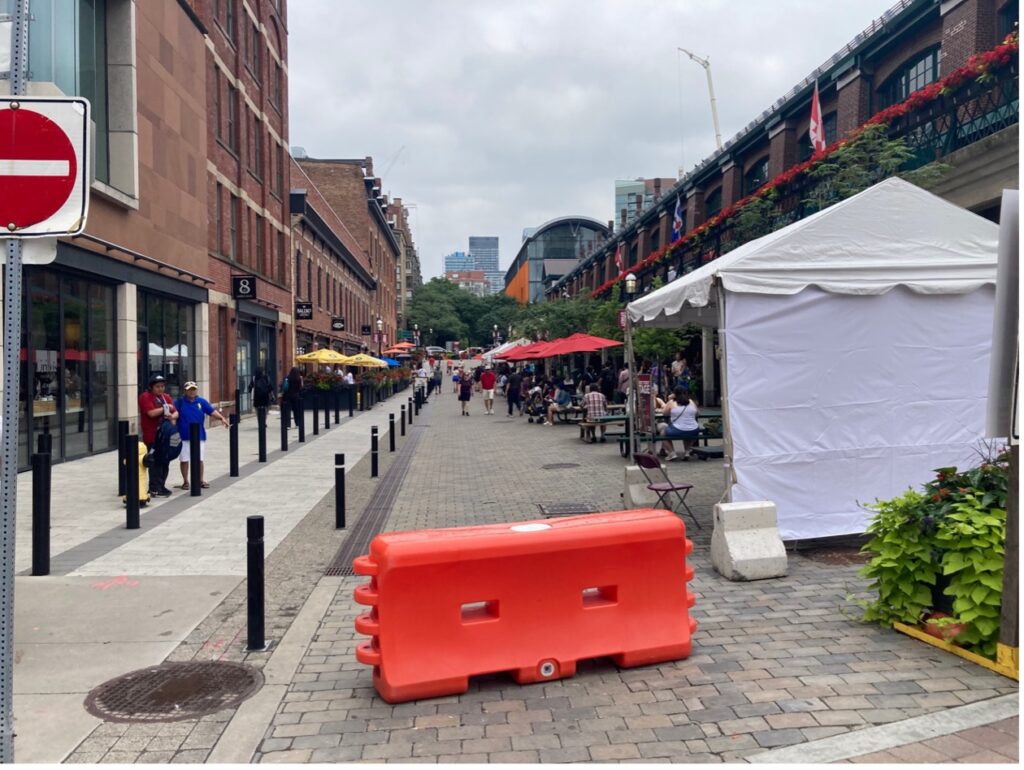Public Spaces
Embracing Flexibility: The Power of Transforming Streets for Placemaking and Street Events in North America (Placemaking Part 1)
This is Part 1 of a 2-part blog series examining shared spaces and placemaking in cities. In this blog, we’ll examine the benefits of maintaining a flexible approach for operating our streets and creating places for people. Part 2 will delve into examples and tools on how we can create great places and flexible streets.
For the better part of a century, the design of our streets and roads has largely prioritized automobile throughput at the expense of placemaking, communities, safety for vulnerable road users, and transit. Think of the many cities that tore out and paved over their streetcar tracks during the 60s and 70s to make room for more cars. For a long time, the pervasive mantra that “roads and streets are for cars” seemed universal, leading to car-centric cultural biases among much of the world’s population. In many cities, that idea still dominates transportation planning, resulting in car-dominated environments that negatively affect the lives of its citizens.
Placemaking, on the other hand, emphasizes the importance of creating vibrant, people-centric spaces. As the concept has gained momentum among urban planners in recent years, we’re also now formally recognizing the need for adaptability in how we operate our streets and roads, prioritizing different modes, users, and placemaking effects based on the time of day, day of week, time of year, and for special events. Add the burgeoning land-value costs associated with ever-increasing employment and population growth, and space for public-use as well as transportation needs becomes even more pertinent.
To achieve great placemaking outcomes, many cities and towns around the world have recognized the need for flexible streets where the nature of traffic can be temporarily changed to open streets for pedestrians and cyclists, either regularly or on occasion, allowing for the transformation of public spaces into lively community hubs.
Benefits of Shared Streets:
Enhancing Vibrancy and Livability:
Reclaiming street space for pedestrians and community activities creates dynamic gathering places that foster social interaction, cultural celebrations, and recreational events. These spaces serve as catalysts for community cohesion and stronger neighborhood identities, ultimately contributing to a higher quality of life for residents. In my travels, I have seen many places that regularly employ the idea of “flexible streets”, whether deliberately or not. For example, numerous European towns and cities close their main street one day a week for outdoor markets — a tradition dating back long before we began accrediting transportation planners and engineers.
Supporting Local Economies:
Transforming streets into vibrant public spaces brings significant economic benefits. Contrary to what many planners and business owners are led to believe, increased foot and cycle traffic generates significantly more sales than increased car traffic (Sources 1, 2). The presence of cafes, restaurants, and shops along pedestrian-friendly streets attracts more customers, boosting revenues and the local economy, which creates a bustling area and a virtuous cycle of increased activity that attracts even more people. In my part of the world, I think of great initiatives such as Market Street in Toronto, Canada, becoming a civic space extension of the St. Lawrence Markets on the weekends in summer and allowing outdoor dining to occur whilst still allowing for movement functions when needed.

Further afield, I’m reminded of events such as the Ramadan Night Markets in Sydney, Australia, where Haldon Street in Lakemba is shut to traffic from dusk till dawn and becomes a magnet for all great Muslim food during the month of Ramadan (supported by transit to achieve mobility). Similarly, eat streets and shopping streets throughout Asia have long been popular, combining placemaking with through slow vehicle movements (when needed) while bolstering the local economy and providing significant business and employment opportunities. In all of these cases, the transition to a human scale of movement results in an environment that invites people to stay and linger, often resulting in more money spent.

Promoting Active Transportation:
Flexible streets play a vital role in promoting active transportation, such as walking, cycling, and scootering. By temporarily removing vehicles, we create safe and inviting spaces that encourage people to choose sustainable modes of transportation. This not only reduces local traffic congestion and air pollution but also improves public health by promoting physical activity. Placemaking and street events become an opportunity to showcase the benefits of active transportation, fostering a culture of mobility that prioritizes the well-being of individuals, communities, and the environment.
A great example of this is the open streets concepts in Montreal that occurs all summer long for certain streets in central Montreal. Being there in the thick of it this summer, I was entranced by the tremendous numbers of people enjoying the outdoor space for dining, relaxing and socialising. The patios were filled to the brim, and the shops filled with customers. Moreover, these streets were also sympathetic for those walking and wheeling, not needing to battle cars and traffic to reach their destination.

Maximising our assets
The ease of changing street operations proves that we don’t have to operate our streets and roads statically— a paradigm shift that moves us toward the goal of using our streets dynamically and thereby making greater use of these substantial assets. In many circles, this is called “sweating the asset”, and it allows us to increase financial sustainability through reduced capital and operational costs.
Conclusion:
The history of shared streets and the benefits they offer as placemaking tools mark a transformative force for our cities. Reclaiming public space from vehicles and creating vibrant, people-oriented places enhances livability, economic vitality, and the social fabric of our urban environments. This shift represents a significant step towards building stronger, more sustainable, and livable cities for future generations.
 ">
">Okka Maw
“Looking at the evolution of towns and cities through the ages, we know that transit, walking and cycling are the most efficient and sustainable ways of moving people. As someone that loves to see cities grow to their full potential, I’m passionate about ensuring we tailor our movement for people.”

